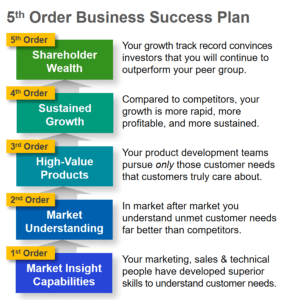Stop Stifling B2B Organic Growth with 2nd Order Effects

In a complex system—like your business—every action leads to a second-order effect (SOE). Some are unknowable. Others are easily predicted but routinely ignored by business leaders. We’ll explore success-stunting SOE’s you should avoid… and a 5th order plan for your B2B organic growth.
A college student studies hard, gets good grades (second-order effect), and begins a rewarding career (third-order effect). Another student rarely misses a party, flunks out (second-order effect), and works at dead-end jobs for 40 years (third-order effect).
Actions have consequences that echo through life, and so it is with business: There are no dominoes you can tip without causing others to tip. If you focus only on the first domino, expect to deal with unintended consequences. These second order effects can either work against you or for you. After looking at some negative consequences, we’ll examine a 5th order plan that can make your B2B organic growth plan much stronger.
There are no dominoes you can tip without causing others to tip.
Fixating on the first domino
Your business was struggling to meet your operating plan this year, so you froze discretionary spending for three months. That was the first domino. The 2nd order effect is you slowed progress on dozens of new-product development projects. Customer interviews, industry expert consultations, outside lab testing, and promotional expenses all had to wait until you decided to sound the “all clear.” B2B organic growth, in other words, would have to wait.
Teams lost significant momentum (especially if they didn’t know when you would lift the freeze) and now require many months to regain it. Product launches are delayed (3rd order effect), and revenue that would have occurred next year is pushed into subsequent years (4th order effect).
Not only do we fail to look ahead to future effects, we fail to learn from past causes. How often have you heard this at a financial review meeting, “Well, one reason our revenue is lagging is that crazy spending freeze we put in place last year”? If you’ve never heard this, it’s because leadership was fixated on the first domino then and remains so today. Better to continually ask, “What are the second and third dominoes if we do this?”
Leadership was fixated on the first domino then and remains so today.
This applies to inaction as well as action: What future dominoes will fall if you retain a borderline-sociopathic leader because he’s delivering good results today? The future dominoes might be losing top-performing employees… spending time and effort to replace them… and halting progress while new hires get up to speed. Expect B2B organic growth to remain elusive in this context.
In most cases, you’ll have a mix of good and bad effects for your decisions, but here’s the caution: Often the good effects are 1st order, while bad effects are 2nd and 3rd order. Conclusion? Spend more time looking past the first domino. First-order actions to evaluate include…
- Cost-savings programs
- Re-organizations
- Hiring freezes
- Mergers and acquisitions
- Major new initiatives
You may decide to proceed with such initiatives, but you’ll do so with eyes wide open… using far-sighted vision instead of near-sighted.
Often the good effects are 1st order, while bad effects are 2nd and 3rd order.
A 5th Order Business Success Plan for B2B Organic Growth
Would you rather be the chess player that thinks only about his or her next move, or the player thinking five moves ahead? I’ve had the opportunity to watch many B2B companies in action and I have some good news for you: For B2B organic growth, it’s likely your opponents are thinking only about their next move.

This illustration lays out a 5th Order Business Success Plan. We’re going to “begin with the end in mind,” as suggested long ago by Steven Covey. Here’s why: Running a large B2B business qualifies as a “complex system,” meaning there are multiple paths to the end-state (in this case shareholder wealth.) By starting at the end, I hope to convince you that this plan—or something very close to it—is likely your best path.
5th Order—Shareholder Wealth: In the near-term, you may be able to pump up your stock price with buybacks, acquisitions that mask underlying weakness, cost-cutting that mortgages your future, or selling a false narrative to Wall Street. But how can you increase shareholder wealth with continuity? By demonstrating your ability to grow more rapidly, profitably, and sustainably than your peer group. For this 5th order effect to happen, the 4th order effect—Sustained Growth—is needed.
4th Order—Sustained B2B Organic Growth: There are so many initiatives you could pursue: lean six sigma, cost-cutting, sales training, global expansion, acquisitions, etc. Many are worthwhile, but for rapid, profitable, sustainable B2B organic growth you have only one path: Your products must meet customer needs better than others. Not convinced the other initiatives fall short? Then check out our new e-book at www.leadersguidetogrowth.com (pp. 14-15)… or watch a 2-minute video at www.leadersguidevideos.com (Episode #6). Here’s more evidence linking high-value products to growth: Our research asked B2B professionals (with over 10,000 years of combined experience) what leads to profitable, B2B organic growth. Their top answer was delivering offerings with strong, differentiated value propositions. (Download this research at www.whatdrivesb2borganicgrowth.com.) Sustained growth won’t happen without the 3rd order effect, High-Value Products.
For rapid, profitable, sustainable growth you have only one path.
3rd Order—High Value Products: You probably agree you must deliver high-value products. But how will you outpace competitors who also agree? Consider two problems you could address better: 1) What’s the right question? (market needs), and 2) What’s the right answer? (supplier solution). I suppose you could try to win on Problem #2… by hiring R&D staff 20% brighter than competitors’. But in the research cited above, B2B professionals said the #1 area they want to improve is market insight. This confirms what most of our clients tell us: More new products fail due to a lack of market understanding than technical shortcomings. This takes us to the 2nd order effect, Market Understanding…
2nd Order—Market Understanding: In a large company, charged with B2B organic growth, you have thousands of customer interactions each year. Imagine your marketing, technical and sales people can do this much better than competitors: They learn all customer needs, which of those needs are most important to meet, why customers want them met, and how much value customers receive from meeting them. With this information, your R&D stops making errors of omission (failing to uncover unarticulated needs) and errors of commission (working on the wrong needs.) This will not happen by itself. You need strong Market Insight Capabilities…
Click here to obtain the Preference Interview Research Report
1st Order—Market Insight Capabilities: For some leading B2B companies, market insight has gone far beyond the decades-old methods of quality function deployment, DFSS, and consumer-oriented VOC. For these B2B companies market insight has now become a “science,” in which market needs are increasingly understood at nine levels of scrutiny. (See Catch the Innovation Wave, at www.aimwhitepapers.com.) Like other methodologies (e.g. lean or six sigma) new tools and skills are required. Here are some of the capabilities practitioners at these leading B2B companies now use day in and day out…
- Conduct interviews that customers lead and appreciate
- Ask probing questions that cause customers to think deeply
- Use special triggers to prompt even more customer thinking
- Uncover insights and opportunities during customer tours
- Filter out their own confirmation bias regarding customer needs
- Stimulate adjacent opportunities due to their respectful approach
- Quantitatively assess customers’ next best alternatives
- Build tight business cases for entering the development stage
From a historical perspective, I don’t believe leaders charged with B2B organic growth have had that many chances to leave competitors in their dust. A necessary condition is for competitors to be performing well below what is possible… and this is certainly happening today. For B2B organic growth, this seems to be a lead-or-be-left-behind juncture.
We’ve just published a new e-book, Leader’s Guide to B2B Organic Growth, which I invite you to download at www.leadersguidetogrowth.com. If you prefer 2-minute videos, the same 30 lessons in this free executive short course can be viewed at www.leadersguidevideos.com. I hope you take time to tip this first domino. The second- and third-order effects could be remarkable, even career-changing.
Comments